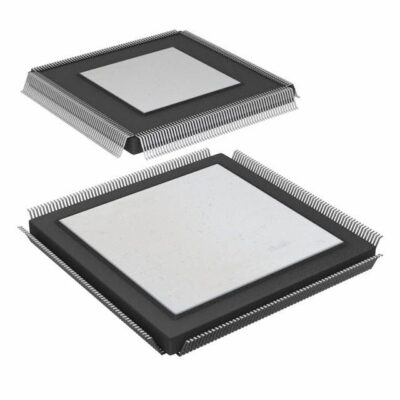ADSP-21060LCW-160
Part Number: ADSP-21060LCW-160
Manufacturer: Analog Devices Inc.
Description: IC DSP CONTROLLER 32BIT 240CQFP
Shipped from: Shenzhen/HK Warehouse
Stock Available: Check with us
ICRFQ.com - Electronic Components Distributor in China Since 2003

Part Number: ADSP-21060LCW-160
Manufacturer: Analog Devices Inc.
Description: IC DSP CONTROLLER 32BIT 240CQFP
Shipped from: Shenzhen/HK Warehouse
Stock Available: Check with us
| Datasheet | |
|---|---|
| Category | Integrated Circuits (ICs) |
| Family | Embedded – DSP (Digital Signal Processors) |
| Manufacturer | Analog Devices Inc. |
| Series | SHARC? |
| Packaging | Tray |
| Part Status | Active |
| Type | Floating Point |
| Interface | Host Interface, Link Port, Serial Port |
| Clock Rate | 40MHz |
| Non-Volatile Memory | External |
| On-Chip RAM | 512kB |
| Voltage – I/O | 3.30V |
| Voltage – Core | 3.30V |
| Operating Temperature | -40°C ~ 100°C (TC) |
| Mounting Type | Surface Mount |
| Package / Case | 240-BFCQFP Exposed Pad |
| Supplier Device Package | 240-CQFP (32×32) |
The ADSP-21060LCW-160 is a 32-bit processor for signal processing that is part of the ADSP-2106x SHARC® family. It has great DSP performance. In this detailed guide, we’ll look at the ADSP-21060LCW-160’s most important features, powers, and uses. This will show how important it is in the worlds of signal processing and embedded systems.
The ADSP-21060LCW-160 is a flexible system-on-a-chip (SoC) that makes the ADSP-21000 DSP core even more useful. This processor was made with high-performance signal processing in mind. It has a number of built-in features that make it a powerhouse in its class.
The ADSP-2106x includes the following architectural features of the ADSP-21000 family core.
The arithmetic/logic unit (ALU), the multiplier, and the switch all run instructions that only take one cycle. The three units are set up in parallel to get the most work done as quickly as possible. Single multifunction instructions do both ALU and multiply tasks at the same time. These computing units can handle IEEE 32-bit singleprecision floating-point, extended precision 40-bit floating-point, and 32-bit fixed-point data types.
A general–purpose data register file is used to move data between the processing units and the data buses and to store intermediate results. When used with the ADSP-21000 Harvard architecture, this 10-port, 32-register (16 main and 16 secondary) register file lets data flow freely between computation units and internal memory.
The ADSP-2106x has an instruction cache built right into the chip. This makes it possible to use three buses to get an instruction and two data values. Only the instructions whose fetches don’t interfere with PM bus data requests are stored in the cache. This means that core, repetitive operations, such as digital filter multiply-accumulates and FFT butterfly processing, can be performed at full speed.
The two data address generators (DAGs) in the ADSP-2106x are hardware circular data banks. Circular buffers are often used in digital filters and Fourier transforms. They make it easy to write delay lines and other data structures needed for digital signal processing. The ADSP-2106x has enough registers in its two DAGs to make up to 32 circular buffers (16 sets of primary registers and 16 sets of secondary registers). The DAGs handle address pointer wraparound automatically, which cuts down on overhead, improves speed, and makes implementation easier. Circular buffers can begin and end in any place in memory.
The ADSP-2106x processors are based on the core design of the SHARC family, but they have better memory and I/O features. These improvements are very important for improving how data is handled and how it connects in signal processing applications that are very demanding.
Because of their memory and I/O interface capabilities, ADSP-2106x processors excel at real-time signal processing, making them excellent for applications like as audio processing, video enhancement, telecommunications, and industrial automation.
Signal chains are essential components of signal processing applications, acting as a series of electronic components for data conditioning and analysis. This article looks about signal chains and how they can be used to process real-time or stored data.
The chain generates an output, which can be a display, a control signal, or data for further processing.
Signal chains find application across diverse fields:
Signal chains are critical to signal processing because they ensure proper data handling, decision-making, and desired outcomes in a variety of fields. Understanding and optimizing them is essential for technological progress.
The ADSP-21060LCW-160 is a remarkable signal processing microcomputer that combines the power of a 32-bit floating-point DSP core with on-chip functionality. Its outstanding performance, optimized memory management, and varied networking make it the best choice for developers across multiple industries. The ADSP-21060LCW-160 is your go-to tool for fulfilling processing demands, whether you’re designing cutting-edge audio equipment or pioneering sophisticated communication systems.
If you’re ready to go on this transforming journey of self-improvement, don’t delay. Connect with ICRFQ, your reliable electronic component partner. Contact us today to learn more about the ADSP-21060LCW-160’s limitless possibilities for your projects.
WhatsApp us